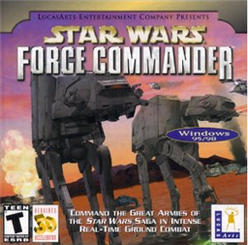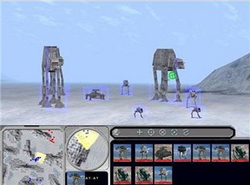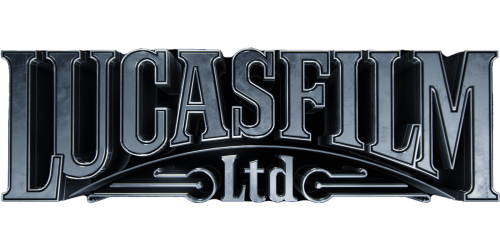| Star Wars: Force Commander | |
|---|---|

| |
| Released: | |
| Developed by: | LucasArts, Ronin Entertainment |
| Published by: | LucasArts |
| Genre(s): | Real-time strategy |
| Rating(s): | |
Star Wars: Force Commander is a real-time strategy video game released for the Microsoft Windows platform on March 21, 2000. It was co-developed by Ronin Entertainment and LucasArts, and published by LucasArts.
Gameplay[]
Template:Expand section The gameplay is much like any other birds eye view strategy game.
Plot[]

Force Commander is the first Star Wars strategy game to be rendered fully in 3D. Previous games used sprites and textured backgrounds.
The game interweaves its story through the events of Episodes IV through VI, sometimes intersecting with known Star Wars events, while telling an original Star Wars story. It is shown from the point of view of a young officer in the Imperial Navy, Brenn Tantor, who begins as a stormtrooper, but soon enough is given his own command. The first task (from the training missions) is to search for an escape pod that landed on Tatooine, and then track the droids that were inside - which is a reference to the opening scenes of Star Wars Episode IV when C3PO and R2-D2 escape Imperial clutches via an escape pod which crashes on Tatooine.
The main character is loyal to the Empire for the first half of the game, until his brother, Dellis Tantor discovers that the Empire killed their father. Dellis is imprisoned by the Empire for revealing this information. Brenn defects to the Rebel Alliance and proceeds to fight his former commanders. As well as the Tatooine training missions, the player participates in the Battle of Hoth (from the Imperial point of view) and the Battle of Endor (as a Rebel). The game ends with the battle to capture the Imperial Palace on Coruscant, and ultimately the liberation of Dellis.
Development[]
Originally conceived as a 2-D strategy game, LucasArts scrapped the overall design after its first public viewing at the 1998 Electronic Gaming Expo. LucasArts decided instead to use an optimized version of a 3-D engine supplied by Ronin Entertainment. The title was jointly developed by LucasArts and Ronin Entertainment, using Ronin's programmers and engine partnered with LucasArts' project leadership, designers, and artists.
The latest and last patch for the game is version 1.1 released in March, 2000. One feature of note in Force Commander is its music, which consists of remixes of John Williams' original Star Wars scores, done by Peter McConnell.[2]
Reception[]
| Reception | |
|---|---|
| Aggregate scores | |
| Aggregator | Score |
| GameRankings | 58.42%[3] |
| Review scores | |
| Publication | Score |
| GameSpot | 6/10[4] |
| PC Zone | 81%[5] |
| Firing Squad | 60%[6] |
Star Wars: Force Commander received mixed critical reception. Gaming Age gave a largely positive review, stating that 'Force Commander lives up to the hype and is a game that deserves a chunk of your precious hard drive space'. Later the review relates that 'the graphics in Force Commander are excellent'.[7] Greg Kasavin of GameSpot gave the game a 6 out of 10.[4] He cited dated graphics, ineffective controls, and flawed gameplay as reason the game "falls short of its ambitious intent."[4] Kasavin conceded the game "has some good ideas. Its campaign has an involving plot and interesting mission objectives", and praised the 3D mission briefings.[4]
PC Zone gave the game an 81%.[5] GameZone gave the game an 8 out of 10.[3] Electric Playground gave the game a 7 out of 10.[3] Nick Woods of Allgame gave a similar score.[8] Sarju Shah of Firing Squad gave the game a 60%.[6]
In a feature on the history of Star Wars games, IGN's Rus McLaughlin called Force Commander "a blocky, buggy, undiluted failure".[9] A similar article in GMR Magazine from March 2004 listed Force Commander as the worst Star Wars game.[10]
References[]
- ↑ 1.0 1.1 Star Wars: Force Commander at GameFAQs
- ↑ From Italian fan-site Lucasdelirium.it's section "Biographies" (folder of Peter McConnell): "His masterpieces come in the last two years of his career as Lucasian: the incredible soundtrack of the wonderful Grim Fandango, steeped in jazz, swing and bizarre Danny Elfman (the composer for Tim Burton), as well as rearrangements in key hard-rock / techno style of John Williams's music for the Star Wars saga, for RTS Star Wars: Force Commander."
- ↑ 3.0 3.1 3.2 Star Wars: Force Commander Reviews and Articles for PC. GameRankings. Retrieved on March 5, 2013.
- ↑ 4.0 4.1 4.2 4.3 Kasavin, Greg (March 24, 200). Star Wars: Force Commander Review. GameSpot. Retrieved on March 5, 2012.
- ↑ 5.0 5.1 PC Zone UK, August 2001
- ↑ 6.0 6.1 Star Wars: Force Commander Review. Firing Squad (April 1, 2000). Retrieved on March 5, 2013.
- ↑ Star Wars: Force Commander Review - Gaming Age Online
- ↑ Woods, Nick. Star Wars: Force Commander review. Allgame. Retrieved on March 5, 2013.
- ↑ McLaughlin, Rus (September 10, 2008). IGN Presents the History of Star Wars Games. IGN. Retrieved on March 5, 2013.
- ↑ New Issue of GMR has me H-A-R-D. Chud (2004-03-02). Retrieved on April 12, 2013.
External links[]
- Official website via the Wayback Machine
- Star Wars: Force Commander on Wookieepedia: a Star Wars wiki
| This page uses content from the English Wikipedia. The original article was at Star Wars: Force Commander. The list of authors can be seen in the page history. As with Lucasfilm Wiki, the text of Wikipedia is available under the GNU Free Documentation License. |
